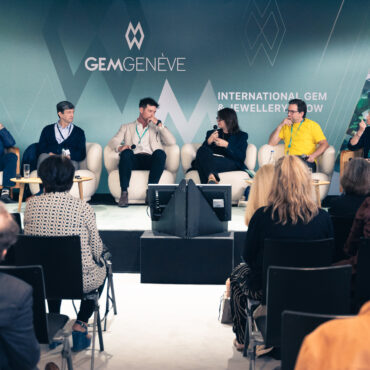GemGenève, the prestigious jewellery exhibition, was set to host a captivating educational-promotional session last May that provided a unique opportunity for exhibitors to share their favourite Art Deco jewels with the audience. This session aimed to delve into the experts’ minds behind these remarkable pieces and uncover the stories that have shaped their expertise. Amanda Triossi, a renowned jewellery historian, guided attendees through a journey of discovery, revealing the hidden gems of GemGenève.
To set the stage for this enlightening session, it is important to understand the origins of the term “Art Deco.” Derived from the famous exhibition of 1925, the Exposition Universelle des Arts Décoratifs, Art Deco became the name of an entire artistic movement. Although initially scheduled for 1916, the exhibition took place in 1925, showcasing truly modern 20th-century jewels. The key features of Art Deco jewellery include geometric designs and, at times, vibrant colours. The movement drew inspiration from various artistic currents, such as Cubism and the use of bold colours in the fine arts. However, what became evident is that Art Deco was not a sudden departure but rather a gradual transition from earlier styles.
The first exhibitor to share their insights is Welsley Aframian, a jewellery expert from L.A. Welsley has chosen three diamond platinum brooches to present. Each piece represents a different stage in the evolution from Edwardian to Art Deco style. The first brooch displays a transitional design, retaining Edwardian elements while incorporating geometric shapes that hint at the emerging Art Deco aesthetic. The second brooch introduces vibrant colours with a square-cut emerald and diamonds, sharp edges, and rigid lines, characteristic of Art Deco. The final brooch showcases a square shape with sharp edges, emphasising the Art Deco geometric style while retaining traces of Edwardian craftsmanship in the detailed platinum work. These pieces exemplify the gradual transition between artistic periods and highlight the expertise of the curators in selecting such representative and wearable jewels.
Next is Elli Abramov from Morelle Davidson, an esteemed figure in the jewellery world. Elli’s passion for jewellery and expertise have been honed over many years of careful observation and continuous learning. He has chosen Bulgari’s stunning late 1920s Art Deco bracelet to share with the audience. This piece stands out for its rarity, exquisite craftsmanship, and use of design elements borrowed from Indian Mogul art. Interestingly, it deviates from the typical Bulgari style seen today, as it was manufactured and retailed in Paris during that period. Elli emphasises the importance of understanding a particular era’s historical context and design choices. This bracelet represents the broader spectrum of Art Deco, encompassing the early 1920s to the mid-1930s, and showcases the evolving trends within the movement.
Garance Brandely from the Faerber Collection in Geneva introduces a unique selection of vanities from Thomas Faerber’s private collection. These vanities, dating back to the mid-1920s, exemplify women’s liberation during the Art Deco period, particularly in makeup and fashion. The vanities were an essential luxury accessory, symbolising the changing societal norms that allowed women to wear bolder makeup and express their style. Garance highlights a Van Cleef & Arpels vanity case crafted by Strauss Allard and Meyer, a renowned workshop in Paris. This case features clever design elements such as multiple compartments for different cosmetic items and showcases the collaboration between the workshop and major jewellery houses. Another vanity case, by Boucheron, incorporates vibrant enamel work and draws inspiration from the Japanese inro boxes. These vanities epitomise the allure and status associated with Art Deco accessories during the 1920s.
Christine Fisher from the Paul Fisher family business in New York concludes the session with Cartier’s selection of a magnificent diamond, platinum, and gold bangle from the 1930s. This iconic piece stands for the exuberance and energy of the Art Deco era. Christine emphasises how this bangle exemplifies the craftsmanship of Cartier and the influence of design trends of the period. The piece’s detachable clips showcase the advancements in jewellery-making technology, specifically the patented clip mechanism introduced in 1927. Christine also shares her journey, recounting how she found herself drawn to the family business despite initially pursuing a medical career. She reflects on the family’s rich history in the jewellery industry, dating back to Vienna in 1850, and their focus on one-of-a-kind treasures.
The stories behind these experts and their chosen jewels illustrate the intricate connection between passion, expertise, and the evolution of jewellery throughout history. From Welsley’s unexpected path into the world of jewellery to Elli’s exploration of rare pieces, Garance’s appreciation for the cultural shifts represented by vanities, and Christine’s fusion of family legacy and personal calling, the session provides a glimpse into the diverse journeys of these knowledgeable individuals.
GemGenève’s educational-promotional session offered attendees a unique opportunity to explore the fascinating world of Art Deco jewellery. Behind each remarkable jewel lies an expert with an exceptional eye whose passion and knowledge bring these hidden gems to light. The gradual transition from earlier styles to the Art Deco movement becomes evident through the carefully chosen pieces presented by the experts. These jewels showcase exquisite craftsmanship and embody the spirit of a transformative era.
As GemGenève continues to captivate jewellery enthusiasts and collectors worldwide, it still is a testament to these timeless treasures’ enduring allure and significance.





